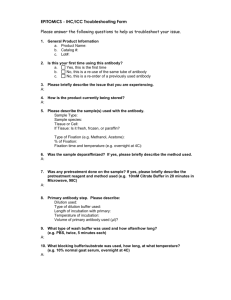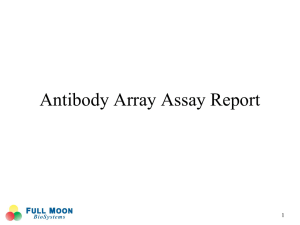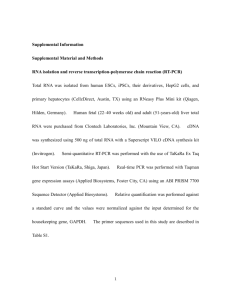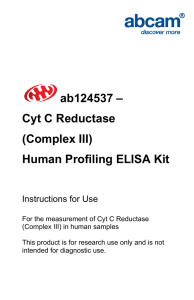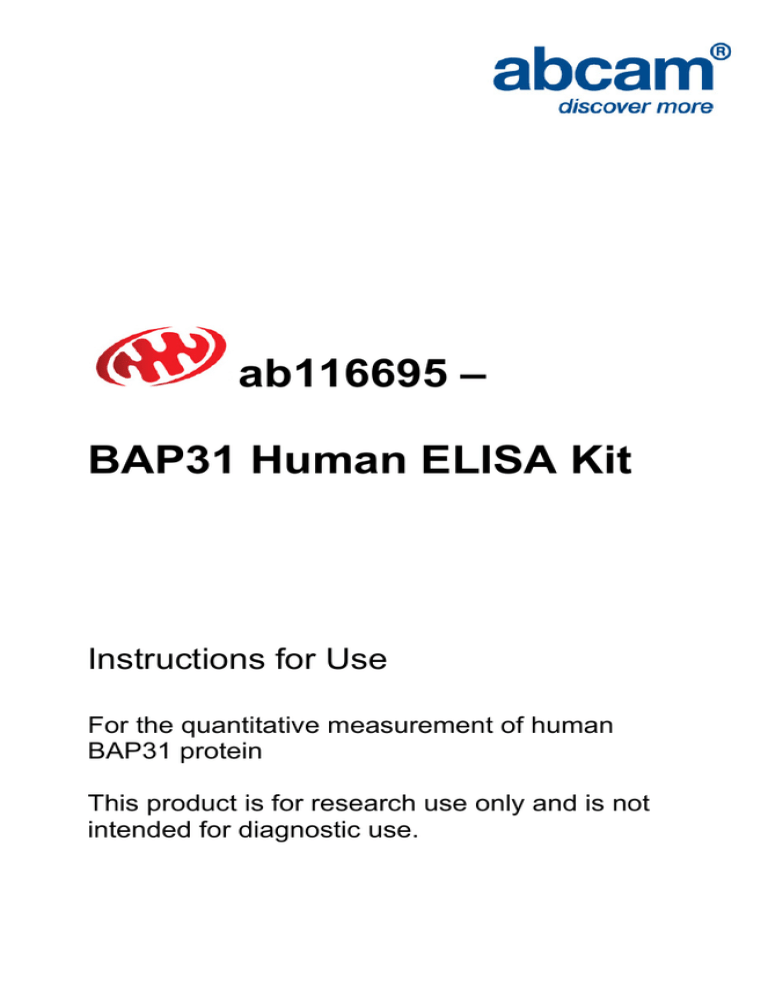
ab116695 –
BAP31 Human ELISA Kit
Instructions for Use
For the quantitative measurement of human
BAP31 protein
This product is for research use only and is not
intended for diagnostic use.
1
Table of Contents
1.
Introduction
3
2.
Assay Summary
5
3.
Kit Contents
6
4.
Storage and Handling
6
5.
Additional Materials Required
7
6.
Preparation of Reagents
8
7.
Sample Preparation
9
8.
Control Sample or Standard Dilution Series Preparation
11
9.
Assay Procedure
13
10. Data Analysis
15
11. Specificity
19
12. Troubleshooting
21
2
1. Introduction
Principle: ab116695 BAP31 Human ELISA kit is an in vitro enzymelinked immunosorbent assay to determine the levels of BAP31
protein in human cell and tissue lysates.
The assay employs a
primary capture antibody specific for BAP31 coated on a 96-well
plate. Samples are pipetted into the wells and BAP31 present in the
sample is bound to the wells by the immobilized antibody. The wells
are washed and an anti-BAP31 primary detection antibody is added.
After washing away unbound detection antibody, HRP-conjugated
detection antibody-specific secondary antibody is pipetted into the
wells.
The wells are again washed, an HRP substrate solution
(TMB) is added to the wells and color develops in proportion to the
amount of BAP31 bound. The developing blue color is measured at
600 nm.
Optionally the reaction can be stopped by adding
hydrochloric acid which changes the color from blue to yellow and
the intensity can be measured at 450 nm.
3
Background:
B-cell
receptor-associated
protein
31
(BAP31,
P51572) is an endoplasmic reticulum (ER) membrane protein.
BAP31 is a target of Caspase-8 and ER-localized Caspase-8L. Thus
it may be used as a marker of apoptosis and/or ER-mediated
apoptosis. It may be actively involved in Caspase-8-mediated
apoptosis. BAP31 may also play a role in anterograde transport of
membrane proteins from the endoplasmic reticulum to the Golgi.
BAP31 forms homodimer and heterodimer with BAP29. It binds
Caspase-8L as a complex containing BAP31, BAP29, BCL2 and/or
BCL2L1. It interacts with VAMP3, VAMP1 and membrane IgD
immunoglobulins. It may interact with ACTG1 and non-muscle
myosin II. It interacts with PTPLB.
Microdeletions in this gene are associated with the contiguous
ABCD1/DXS1375E deletion syndrome (CADDS; MIM 300475).
Northern blot analysis indicated higher expression of BAP31 in
breast cancer cells and pancreatic tissue compared with other
tissues and cell lines.
4
2. Assay Summary
Bring all reagents to room temperature. Prepare all the reagents
and samples as instructed.
Add 50 L sample to each well used. Incubate 2 hours at room
temperature.
Aspirate and wash each well two times. Add 50 L prepared 1X
Detector Antibody to each well. Incubate 1 hour at room
temperature.
Aspirate and wash each well two times. Add 50 L prepared 1X
HRP Label. Incubate 1 hour at room temperature.
Aspirate and wash each well three times. Add 50 L TMB
Development Solution to each well. Record immediately the
color development with time at 600 nm for 15 minutes.
Alternatively add 50 L Stop solution at a user-defined time and
read at 450 nm.
5
3. Kit Contents
Item
Quantity
20X Buffer
20 mL
Extraction Buffer
15 mL
10X Blocking Buffer
6 mL
TMB Development Solution
6 mL
10X BAP31 Detector Antibody
10X HRP Label
0.7 mL
1 mL
Microplate 96 antibody coated wells in 12 strips
1
4. Storage and Handling
Store all components at 4°C.
The kits are stable for at least 6
months. Unused microplate strips should be returned to the pouch
containing the desiccant and resealed.
6
5. Additional Materials Required
Microplate reader capable of measuring absorbance at 600
nm (or 450 nm after addition of Stop solution - not supplied).
Method for determining protein concentration (BCA assay
recommended).
Deionized water
Multi and single channel pipettes
PBS (1.4 mM KH2PO4, 8 mM Na2HPO4, 140 mM NaCl, 2.7
mM KCl, pH 7.3)
Tubes for sample dilution
Stop solution (optional) – 1N hydrochloric acid
Optional plate shaker for all incubation steps
7
6. Preparation of Reagents
1. Bring all reagents and samples to room temperature (1825°C) before use.
2. Prepare 1X Wash Buffer by adding 20 mL 20X Wash Buffer
to 380 mL nanopure water.
3. Prepare 1X Incubation Buffer by adding 6 mL 10X Blocking
Buffer to 54 mL 1X Wash Buffer. After performing the ELISA
freeze unused 1X Incubation Buffer.
4. Dilute the BAP31 detector antibody 10-fold with 1X
Incubation Buffer immediately before use. Prepare 0.5 mL
for each strip used.
5. Dilute the HRP label 10-fold with 1X Incubation Buffer
immediately before use. Prepare 0.5 mL for each strip used.
8
7. Sample Preparation
Note on buffer supplements:
Extraction buffer can be
supplemented with protease inhibitors such as PMSF and a
protease inhibitor cocktail prior to use. The data shown in this
protocol was generated with Extraction Buffer supplemented
with a generic protease inhibitor cocktail. Supplements should
be used according to manufacturer’s instructions.
Cell lysates:
1. Collect non adherent cells by centrifugation or scrape to
collect adherent cells from the culture flask. Typical
centrifugation conditions for cells are 500 g for 10 min at
4°C.
2. Rinse cells twice with PBS.
3. Solubilize cell pellet at 2x107/mL in Extraction Buffer.
4. Incubate on ice for 20 minutes. Centrifuge at 16000 x g at
4°C for 20 minutes. Transfer the supernatants into clean
tubes and discard the pellets. Assay samples immediately
or aliquot and store at -80°C. The sample protein
concentration in the extract may be quantified using a
protein assay.
9
Tissue lysates:
1. Tissue lysates are typically prepared by homogenization
of tissue that is first minced and thoroughly rinsed in
PBS to remove blood (dounce homogenizer
recommended).
2. Suspend the homogenate to 25 mg/mL in PBS.
3. Solubilize the homogenate by adding 4 volumes of
Extraction Buffer to a sample protein concentration of 25
mg/mL.
4. Incubate on ice for 20 minutes. Centrifuge at 16000 x g
at 4°C for 20 minutes. Transfer the supernatants into
clean tubes and discard the pellets. Assay samples
immediately or aliquot and store at -80°C. The sample
protein concentration in the extract may be quantified
using a protein assay.
Sub-cellular organelle lysates e.g. ER:
1. Prepare the organelle sample by, for example, subcellular fractionation.
2. Pellet the sample.
10
3. Solubilize the pellet by adding 9 volumes Extraction
Buffer.
4. Incubate on ice for 20 minutes. Centrifuge at 16000 x g
4°C for 20 minutes. Transfer the supernatants into
clean tubes and discard the pellets. Assay samples
immediately or aliquot and store at -80°C. The sample
protein concentration in the extract may be quantified
using a protein assay.
The sample should be diluted to within the working
range of the assay in 1X Incubation Buffer. As a guide,
typical ranges of sample concentration for commonly
used sample types are shown below in Data Analysis.
8. Control
Sample
or
Standard
Dilution
Series Preparation
Note: It is strongly recommended to prepare a dilution series of
the control (untreated) material. The relative levels of BAP31 in
other (treated) samples can be interpolated from within this
control sample series.
1. To create a dilution series of control sample label tubes #17. Add 150 L 1X Incubation Buffer to each of tubes #2
through #7.
11
2. Prepare all samples by detergent extraction as described in
section 7. Dilute the control sample lysate to 1 mg/mL in 1X
Incubation Buffer, label this tube #1.
Undiluted control
sample can be frozen at -80°C.
3. Transfer 150 L from tube #1 to tube #2. Mix thoroughly.
With a fresh pipette tip transfer 150 L from #2 to #3.
4. Repeat for Tubes #4 through #7. Use 1X Incubation buffer
as the zero sample tube labeled #8. Use a fresh dilution
series for each assay.
150 l
1
150 l
2
Control sample
(1 mg/mL)
1/2
in
1X Incubation Buffer
150 l
150 l
150 l
3
4
5
1/4
1/8
1/16
6
1/32
150 l
7
1/64
12
9. Assay Procedure
Bring all reagents and samples to room temperature before use.
It is recommended all samples and standards be assayed in
duplicate.
1. Prepare all reagents, working standards, and samples as
directed in the previous sections.
2. Remove excess microplate strips from the plate frame,
return them to the foil pouch containing the desiccant pack,
and reseal.
3. Add 50 µL of each diluted standard or sample per well. It is
recommended to include a dilution series of a control
(normal) sample as a reference.
Also include a 1X
Incubation Buffer as a zero standard.
4. Cover/seal the plate and incubate for 2 hours at room
temperature.
If available use a plate shaker for all
incubation steps at 300 rpm.
5. Aspirate each well and wash, repeat this once more for a
total of two washes. Wash by aspirating or decanting from
wells then dispensing 300 L 1X Wash Buffer into each well
as described above.
Complete removal of liquid at each
step is essential to good performance. After the last wash,
13
remove the remaining buffer by aspiration or decanting.
Invert the plate and blot it against clean paper towels to
remove excess liquid.
6. Immediately before use prepare sufficient (0.5 mL/strip
used) 1X Detector Antibody in 1X Incubation Buffer. Add 50
L 1X Detector Antibody to each well used. Cover/seal the
plate and incubate for 1 hour at room temperature.
If
available use a plate shaker for all incubation steps at 300
rpm.
7. Repeat the aspirate/wash procedure above.
8. Immediately before use prepare sufficient (0.5 mL/strip
used) 1X HRP Label in 1X Incubation Buffer. Add 50 L 1X
HRP Label to each well used.
Cover/seal the plate and
incubate for 1 hour at room temperature. If available use a
plate shaker for all incubation steps at 300 rpm.
9. Repeat the aspirate/wash procedure above, however,
performing a total of three washes.
10. Add 50 µL TMB Development Solution to each empty well
and immediately record the blue color development with time
in the microplate reader prepared with the following settings:
14
Mode:
Kinetic
Wavelength:
600 nm
Time:
up to 15 min
Interval:
20 sec - 1 min
Shaking:
Shake between readings
Alternative– In place of a kinetic reading, at a user defined,
time record the endpoint OD data at (i) 600 nm or (ii) stop
the reaction by adding 50 µL Stop solution (1N HCl) to each
well and record the OD at 450 nm.
11. Analyze the data as described below.
10.
Data Analysis
Average the control sample dilution series readings and plot against
their concentrations after subtracting the zero standard reading.
Draw the best smooth curve through these points to construct a
standard curve.
Most plate reader software or graphing software
can plot these values and curve fit.
A four parameter algorithm
(4PL) usually provides the best fit, though other equations can be
examined to see which provides the most accurate (e.g. linear, semilog,
log/log,
4
parameter
logistic).
Read
BAP31
protein
concentrations for unknown samples from the standard curve
15
plotted. Samples producing signals greater than that of the highest
standard should be further diluted in 1X Incubation Buffer and
reanalyzed, then multiplying the concentration found by the
appropriate dilution factor.
Change mOD/min (600 nm)
TYPICAL CONTROL SAMPLE CURVE - For demonstration only.
Control
sample
g/mL
100
1000
10
500
1
10
250
100
HepG2 concentration ( g/mL)
1000
125
62.5
31.25
15.625
Change
mOD/min
(600 nm)
248.1
235.6
241.4
172.9
157.8
156.0
86.0
83.3
95.2
36.6
33.9
36.0
15.0
16.8
14.7
9.1
8.6
8.1
6.1
6.3
5.5
16
Typical Working Ranges
Tissue extract (e.g. Liver)
62 - 1000 µg/mL
Whole cultured cell extract
31 - 1000 µg/mL
SENSITIVITY
Calculated minimum detectable dose of BAP31 (zero dose n=25 + 2
standard deviations) is present in 21 g/mL HepG2 extract.
LINEARITY OF DILUTION
Linearity of dilution was determined by comparing dilution series of
human heart muscle (HHH) extract to dilution series of HepG2 cells.
1000 g/mL HHH
Percent expected
(fold of dilution)
undiluted
100
2
104
4
100
8
74
17
REPRODUCIBILITY
HepG2 extract
CV %
(31-1000 g/mL)
Intra (n= 3-4, 4 assays)
13.9 (maximum)
Intra (n=3-4, 4 assays)
6.2 (average)
Inter (n=4 days)
9.3 (maximum)
Inter (n=4 days)
5.1 (average)
RECOVERY
500 g/mL HepG2 in
Average %
Recovery
Range %
Cell culture media
90
80-100
100% Extraction Buffer
125
114-135
18
11.
Specificity
Species– human reactive.
Rat and mouse not reactive. Others
untested.
BAP31 (arbitrary units)
1000
800
600
400
200
0
Vehicle
Staurosporine
Figure 2. Example of BAP31 reduction in Jurkat cells undergoing
apoptosis.
Analysis of extracts (1000 g/mL), prepared from Jurkat cells treated
for 6 hours with 1 M Staurosporine or mock-treated (Vehicle), with
the use of this kit. The relative BAP31 concentrations were
interpolated from control sample curve of HepG2 cells as described
in the protocol. The data show that the Staurosporine treatment
decreased BAP31 levels to 40%.
19
Figure 3. Example of reduction of full-length BAP31 in HeLa cells
undergoing apoptosis.
Western blot analysis of whole cell lysates, prepared from HeLa cells
treated for 4 hours with 1 M Staurosporine (lane 2) or mock-treated
(lane 1), using the same BAP31 antibody used in this kit as capture
antibody. BAP31 is known to have two caspase cleavage sites; it
can be cleaved to an amino-terminal p19 fragment, a central p8
fragment and carboxy-terminal p1 fragment. The data show that the
Staurosporine treatment strongly reduced the full-length BAP31
protein (p28). Besides the full-length protein, this antibody also
detected p27 cleavage intermediate (p19+p8) and p8 cleavage
fragment (not shown in this figure) in Staurosporine-treated cells,
localizing this antibody epitope most likely within the BAP31 p8
fragment. The BAP31 detector antibody in this ELISA is available as
a standalone antibody ab112993.
20
12.
Troubleshooting
Problem
Cause
Solution
Poor standard
Inaccurate pipetting
Check pipettes
Too brief incubation
Ensure sufficient
times
incubation time;
curve
Low signal
standard/sample change
incubation to over night
Large CV
Inadequate reagent
Check pipettes and
volumes or improper
ensure correct
dilution
preparation
Plate is insufficiently
Review the manual for
washed
proper wash. If using a
plate washer, check that
all ports are un
obstructed.
Make fresh Wash Buffer
Contaminated Wash
Buffer
21
Problem
Cause
Solution
Low
Improper storage of
Store kit at 4°C. Keep
sensitivity
the ELISA kit
substrate solution
protected from light.
Store sample extracts
at -80°C.
22
UK, EU and ROW
Email:
technical@abcam.com
Tel: +44 (0)1223 696000
www.abcam.com
US, Canada and Latin America
Email: us.technical@abcam.com
Tel: 888-77-ABCAM (22226)
www.abcam.com
China and Asia Pacific
Email: hk.technical@abcam.com
Tel: 108008523689 (中國聯通)
www.abcam.cn
Japan
Email: technical@abcam.co.jp
Tel: +81-(0)3-6231-0940
www.abcam.co.jp
23
Copyright © 2012 Abcam, All Rights Reserved. The Abcam logo is a registered trademark.
All information / detail is correct at time of going to print.

